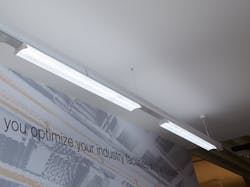Osram partners with Nokia for indoor 5G through the lights
IoT lighting continues to evolve. This project is in the early stages.
Two of the biggest names from the lighting and cellular networking industries — Osram and Nokia — are together exploring the possibility of equipping LED ceiling luminaires with 5G radio chips to transmit data inside commercial buildings.
Interested in articles & announcements on IoT lighting?
In an early-stage development project, Osram said it is providing luminaires and its knowledge of building services, and Nokia Bell Labs is providing networking expertise, to test the lighting infrastructure as a possible means to boost and transmit 5G signals indoors. The wireless transmission would connect to an end user's wired backhaul to offer complete Internet service.
No mobile operators are currently involved in the development, which is centered at Osram and Nokia facilities in Munich, Osram's home city. The two companies have trialed the technology in live offices, although Osram declined to identify where.
“Our office and industrial luminaires are already networked for remote control,” said Thorsten Müller, head of innovation at Osram. “In this R&D project, we equipped them with special broadband radio modules, allowing mobile devices like cell phones and laptops to connect to the luminaire network and transmit data.”
The installations have included “IP enabled 'network slicing' and 'IoT micro services' in the luminaire’s LED driver and light management system,” one Osram spokesperson told LEDs Magazine.
There's 5G in them thar lights. But will it be gold? (Photo credit: Osram.)
5G, generally expected around 2020, marks the next big leap in mobile networking speeds and bandwidth. Like current 4G and earlier-generation mobile phone signals, however, reception can suffer inside commercial buildings.
Some people think that 5G will provide a huge financial boost for smart IoT lighting, especially outdoors, as it could convince investors to pony up for projects that use the street-lighting infrastructure as a backbone to 5G networks that collect data on all sorts of thing like traffic, parking, air quality, noise, crowds, and so forth.
The prospects for using a 5G/lighting combination indoors are also tantalizing. Osram and Nokia mark the latest example of joint industry development efforts. In another indoor trial, Finnish lighting company Helvar has outfitted about 100 indoor luminaires with 5G capability at the University of Oulu on Finland's west coast.
But as is generally the case with lighting companies trying to transmute into IT providers, facility managers might not see the logic of using the lighting infrastructure for IT purposes. Building operators who wish to install indoor 5G networks might choose to do so independent of the lighting network.
Osram noted that luminaires could house many Internet of Things (IoT) chips and sensors, not just 5G. The mobile networking chips would join a growing stable of offerings such as Bluetooth and occupancy sensors that Osram provides to support a range of services, such as asset tracking, facilities management, indoor navigation, and more. They would fit into the Lightelligence architecture that Osram introduced in March to support IoT lighting.
“Our light installations are getting smarter and smarter,” Osram’s Müller noted. “Presence detectors in office buildings can already be used to manage meeting rooms more efficiently and plan targeted cleaning as and when required. In retail stores, customers can be better addressed with the help of localized digital services.”
But again, Osram, like other lighting companies, will compete against IT companies for those services For instance, Barclays plc has outfitted its London investment bank offices with occupancy sensors — just the sort of thing that lighting vendors hope to house in luminaires — without involving the lighting infrastructure.
Thus, Osram and other lighting companies are striking partnerships with IT and networking companies — such as Osram's new alliance with Nokia. Lighting companies are trying to find the right “co-opetition” balance with the IT world. In that give-and-take mode, Osram has even been known to play a more straight-up IT role, providing Bluetooth communication chips in cases where it is not the lighting vendor, such as at the Guess and Marc O'Polo retail chains in Switzerland.
For full-on wireless Internet service, Osram noted that 5G would “perform better and will generate lower costs than Wi-Fi access points and repeaters.”
Another option is Li-Fi, a technology that comes straight from the lighting world as it embeds data in light waves emitted by LEDs, rather than in the radio spectrum of 4G, 5G, and Wi-Fi.
A second Osram spokesperson told LEDs that Osram views Li-Fi as complementary to 5G rather than as competing. One disadvantage of Li-Fi is that it only works when the lights are on, the spokesperson pointed out.
Lighting companies are also using other technologies such as Bluetooth, ZigBee, and other radio techniques, as well as wired Ethernet, to provide a range of services short of full-on Internet access. For example, as our sister magazine Lux wrote this week, Elon Musk's Tesla plans to outfit part of its Fremont, CA factory with smart IoT lighting controlled by a Bluetooth network.
LEDs Magazine editor in chief Maury Wright contributed to this story.
MARK HALPERis a contributing editor for LEDs Magazine, and an energy, technology, and business journalist ([email protected]).

Mark Halper | Contributing Editor, LEDs Magazine, and Business/Energy/Technology Journalist
Mark Halper is a freelance business, technology, and science journalist who covers everything from media moguls to subatomic particles. Halper has written from locations around the world for TIME Magazine, Fortune, Forbes, the New York Times, the Financial Times, the Guardian, CBS, Wired, and many others. A US citizen living in Britain, he cut his journalism teeth cutting and pasting copy for an English-language daily newspaper in Mexico City. Halper has a BA in history from Cornell University.





